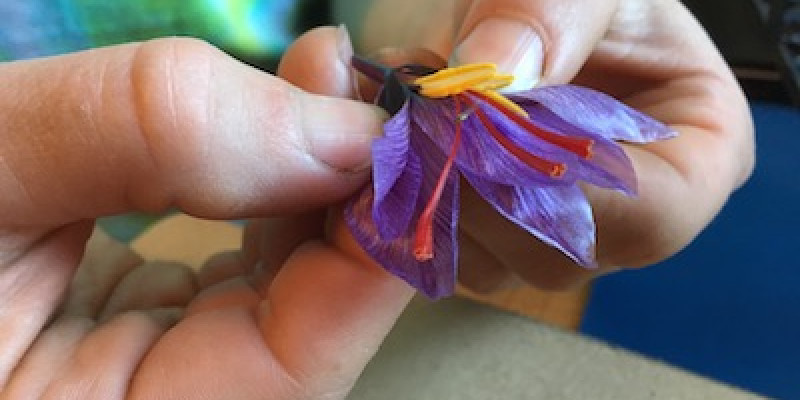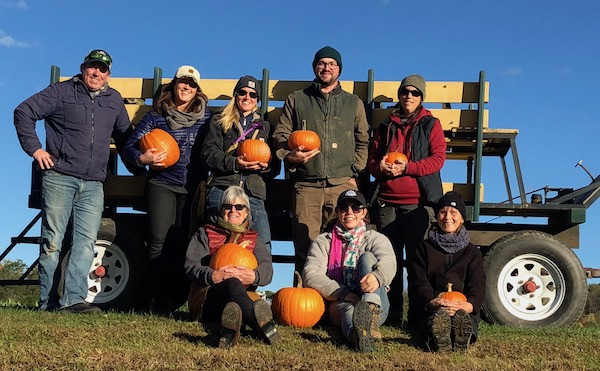Saffron, Salmon, School Programs, Storage Crops
It’s only the third week of October and already we’ve seen both snow and frost. To protect the more fragile crops like lettuces, kale, and spinach, we’re keeping them covered with Reemay. The pumpkins get tucked in every night, too.
You can do this too, even if you don’t have reemay at home. If you can’t bring your pumpkins and plants inside at night (or don’t want to), just cover them with sheets, blankets, towels, or any old fabric. This will provide some insulation and keep them protected from the cold a bit longer.
When it warms up in the morning, we uncover the pumpkins for you to come pick when the farmstand is open! Pumpkin picking is a great way to kick off farm BINGO – you can cross off two of the activities on the sheet (or three if you go in the corn tee-pee). When you get five in a row, fill out the bottom of the sheet and drop it off in the farmstand to be entered in the raffle to win a free t-shirt at the end of the month.
In the farmstand
Bulbs are 25% off in the farmstand. The ground isn’t completely frozen yet, which means there’s still time to plant. Click here to read about fall bulbs and other fall gardening tips for New England.
Papa’s Catch Salmon delivered Wild Alaskan Sockeye Salmon to the farmstand on Thursday. Caught this past summer in Bristol Bay, the fish was professionally processed (pin bones removed), vacuum packed, and flash frozen within 24 hours. The head fisherman, Josh, recommends buying fish frozen unless you can be sure that it was caught within the last 72 hours. To get the most out of your fillet, you should cook it as soon as it thaws. Read Josh’s tips on thawing and cooking salmon here. Price: $17.50/lb
From the fields
When asked about production, Nic said “we’re all frozen up just like the fields”. While that’s not entirely true as there’s still work to do, much of the harvesting, plowing, etc. is done at this point. This week the crew finished getting the bulk produce (carrots, potatoes, turnips, radishes, celeriac) out of the ground and now they’re working on processing. We’ll harvest greens for at least another month or so, if all goes well, and we’ll let the parsnips sit in the ground a bit longer. They taste better after a few frosts!
Experimenting with saffron
Did you know that saffron is derived from the flower of the “saffron crocus”, or crocus sativus? We planted a test plot of the bulbs last fall, and they just started blooming last week. Every morning, our greenhouse staff harvest the new blooms, remove the petals, and set aside the stigmas (or threads) to dry. Once dried, they’re used mainly as a seasoning in various dishes.


It takes 80,000 crocus flowers to make one pound of the spice. It’s no wonder that saffron is the world’s most expensive spice. Thankfully, just a small pinch can add a burst of flavor and a pop of golden color to a dish.
Fall Farm Education
The Little Farmers Saturday Program is CANCELLED today and will not be held on Saturdays for the remainder of the season. We’ll run the last two Tuesday classes, on October 23 and 30.
In October, school groups from around the Upper Valley come to the farm for fall field trips, to learn about pumpkins. One of the highlights of the day – besides the wagon ride and pumpkin picking – is “pumpkin yoga”, which we use to teach the life cycle of the plant.

A group of farm educators was here Monday and Tuesday to shadow, participate in, and critique our education programs. This “Farm-Based Education Immersion” experience, hosted in conjunction with the Farm Based Education Network, allowed us to share our programming with other educators, gain valuable feedback, and learn about other approaches as well!
Country Walkers also stopped by for a quick farm tour and a lunch. The kitchen whipped up a delicious lunch for both groups, which consisted of stuffed peppers, hail the kale salad, and assorted cookies, served with hot beverages.
Upcoming events
- Saturday, Oct. 20 – Little Farmers CANCELLED
- Sunday, Oct. 21 – Knife Sharpening (10am–2pm)
- Monday, Oct. 22 – Cooking for Middle Schoolers (3:30-5:15pm)
- Tuesday, Oct. 23 – Little Farmers (10–11am, weekly), Homeschool Farm Science (1-3pm)
- Wednesday, Oct. 31 – Last day of regular hours, Farm BINGO raffle!
- Thursday, Nov. 1 – Farmstand & Hello Cafe CLOSED
- Friday, Nov. 2 – Farmstand opens at 12pm; fall hours begin

_BDP-4552_1600_600_90_s_c1.jpg)





